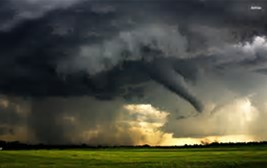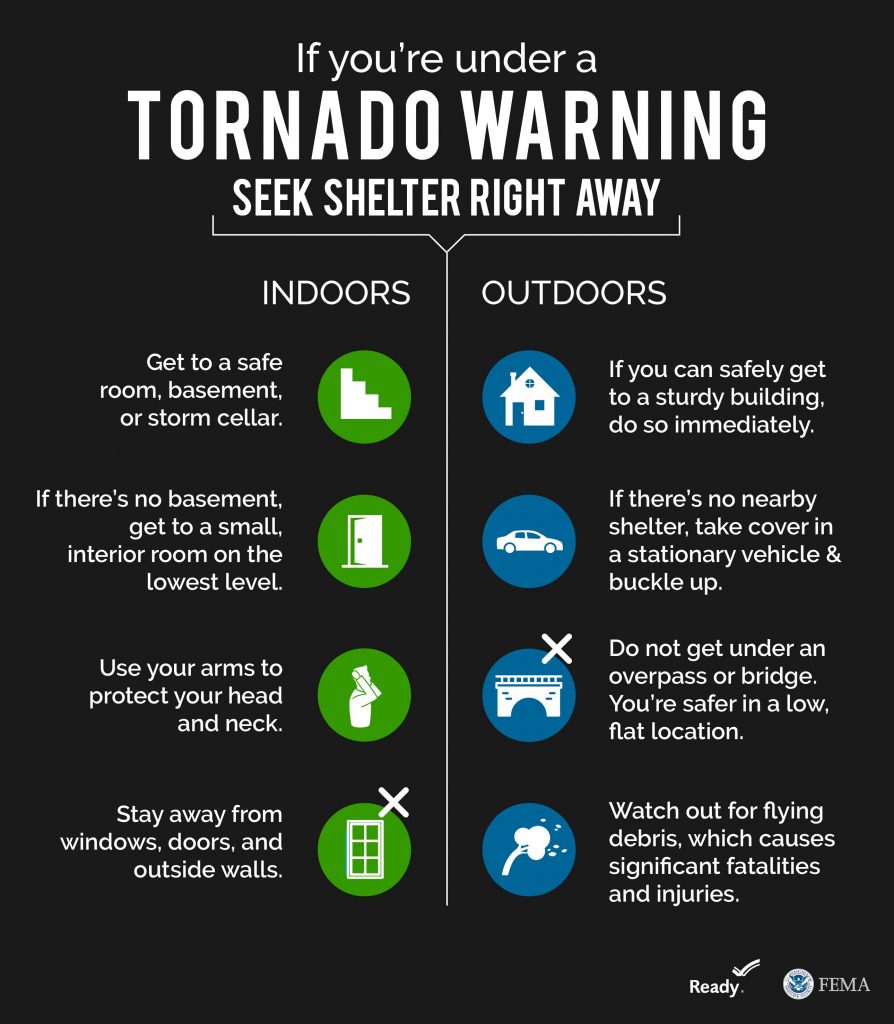Tornadoes form when cold, dry air meets with warm, moist air. A whirlwind is created by a gust of warm air rising in a spiral motion, causing water vapor to be swept upward. As the warm air cools, a twisting, spiral shaped cloud forms. The tornado is a violently rotating column of air that extends from a thunderstorm with winds that can range from 65mph to over 200mph.
Know your Terms:
Tornado Watch – means that conditions are favorable for the development of tornadoes.
Tornado Warning – is issued when a tornado is imminent or occurring.
Before a Tornado
- Be alert for changing weather conditions when storms approach. Listen to NOAA Weather Radio or local media for the latest weather information.
- Develop your own disaster plan- build a kit, make a family communications plan and be informed and know what to do before, during and after an emergency.
- If you or a family member has special needs, register with your emergency management agency, police and/or fire department before any disaster strikes.
- Know where to go to seek shelter- at work, school, home, in your car, in public buildings or mobile homes.
- If you are considering building a storm shelter, check out information at: Storm Shelter Guide from Consumer Affairs.
During a Tornado
- Seek shelter immediately if a tornado warning is issued. No place outside is safe from a tornado.
- At Home: Go to the lowest level and as close to the center of your house as possible. The basement, a windowless bathroom, closet or inside hallway. Stay away from windows. Exterior rooms and rooms with windows will not protect you. Top floor rooms in your house will not protect you either. If you have a storm shelter, use it.
- At Work or School: Follow teachers’ instructions or safety officers. Go to an inside wall on the lowest floor. Interior bathrooms or closets make a good shelter area. Avoid large, open rooms like gymnasiums, cafeterias or auditoriums where roofs can collapse.
- In a Mobile Home: Get out and seek shelter in a designated storm shelter or the lowest floor of a sturdy building nearby.
- In your Car: Never try to outrun a tornado. Seek shelter in a nearby sturdy building. If no buildings are nearby, then get lower than the roadway by lying flat in a ditch and covering your head with your hands. Highway overpasses offer no protection from a tornado and should not be used as shelter.
- In a Public Building: Go to a middle hallway on the lowest floor. Many public places have designated shelter areas-learn to look for these signs.
- Remember to DUCK- Go DOWN to the lowest level; Get UNDER something sturdy like a staircase, heavy table or desk; COVER your head; KEEP in a shelter until the storm passes.
After a Tornado
- Check for injuries. Do not attempt to move seriously injured people unless they are in danger.
- Be careful of debris suck as damaged structures, exposed nails, broken glass or damaged trees.
- Do not touch downed power lines.
- Use caution when you start clearing up the debris.
Remember that tornadoes can occur day or night, during any time of the year. The best defense when severe weather threatens is preparedness.


